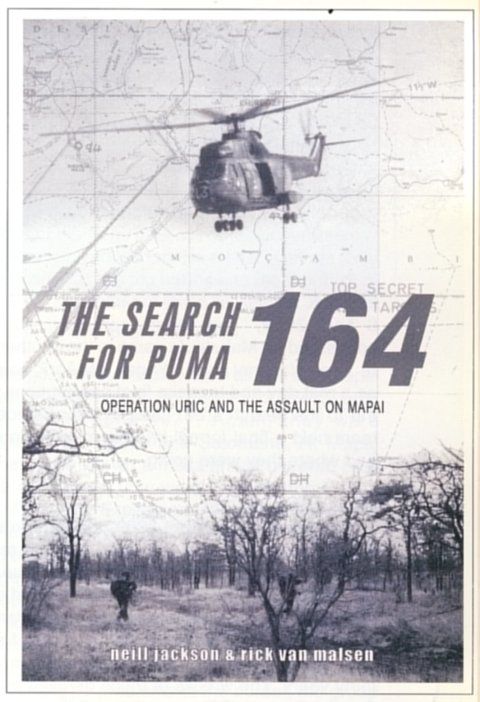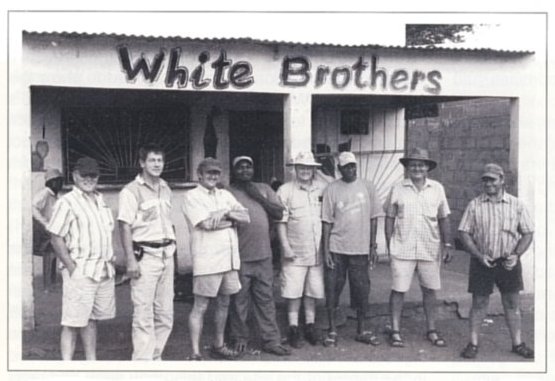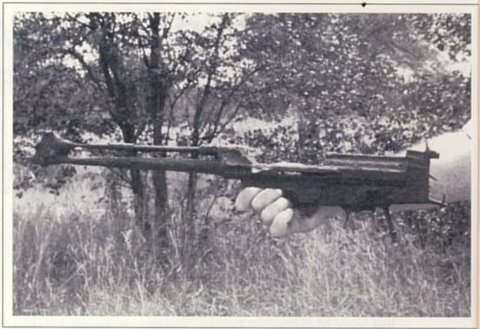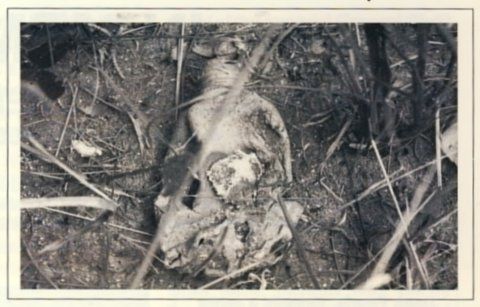

 The South African
The South African
Under the cover of darkness, on the night of 6 September 1979, the writer was flown out of the forward admin area of Op Uric, situated deep in the Mozambique bush, to the Operational Forward HQ situated at Chipinda Pools. On board with him was Sgt-Maj Graham 'Log' Enslin of Support Commando, Rhodesian Light Infantry (RLI), whose brother Brian, a trooper with 1 Commando, was one of seventeen men killed earlier that day when their South African Air Force Puma helicopter had been shot down in the approach to the attack on the enemy base at Mapai, in Mozambique's Gaza Province.
The writer's grim task on arrival at Chipinda Pools would be to sort out and send Noticas signals for the fatalities suffered on that fateful day. Immersed in his own thoughts during the fortyodd minute flight back to the Rhodesian border, he vowed that he would one day return to the crash site to honour his friends and comrades-in-arms who had made the supreme sacrifice that morning, but who, because of operational expediency, had to be left behind where they had died.

This new book to be published by 30° South Publishers in 2011, includes a backround to the operation.

The search team pose with their new brothers outside a store in the town of Mapai.
From left to right: Kevin Jones, Stan Standish-White, Rick van Malsen, Solomone (interpreter),
Neill Jackson, Arlindo Baloi, Malcom Macrimmon and the late Duff Odendaal.
The Expedition
Twenty-nine years later, Rick van Malsen was privileged enough to be invited to join Bob Manser's expedition to find the Donaldson Canberra lost over the Malvernia area in January 1977. It became plainly obvious during this search that the local police, militia, and Mozambicans were more than willing to assist in the location of these war sites and bore absolutely no malice towards their former adversaries. It was then that the writer realised that it was possible to honour the pledge that he had made in 1979.
Slowly, over a period of five months, he was able to assemble a 'Team' for the Mapai expedition by using the members of the earlier Canberra expedition as the nucleus. Regrettably, neither Bob Manser nor Alistair Macrimmon were able to take part in the new expedition, so Neill Jackson (exSupport Commando, RLI) and 'Stan' Standish White (ex- SAS) volunteered their I services. Added to these volunteers were Eastern District farmers Duff Odendaal and his son-in-law, Gareth Barry. The final search team was thus made up as follows: Rick van Malsen, Kevin Jones, Malcolm Macrimmon, Neill Jackson, 'Stan' Standish White, Duff Odendaal, and Gareth Barry.
Nearly 200 e-mails were sent out globally as the team planned, sourced information, obtained eye witness accounts, speculated on where the actual site was, made up letters of introduction and catch phrases in Portuguese, and sorted out the administration and logistics. It finally all came together and, on Thursday, 9 April 2009, 'The Team', complete with wives, converged on Mabalauta camp in the southern Gona re Zhou National Park. Friday, 10 April, was used as a rest day and to make final preparations for the trip to the search area. Later in the afternoon, the team held a final formal briefing on what to expect and where they were going.
The search begins
On Saturday, 11 April 2009, the team rose early and left camp at 05.00 in two vehicles to reach the border at the official opening time, 06.00. True to form, the bleary-eyed border officials only arrived at 06.45 and the group only completed their border formalities at 08.00, an hour behind schedule. They found the road down to Mapai mostly unchanged over the last thirty years. The wrecks of trains derailed by various Special Forces' (SF) operations all those years ago were still in evidence, as were many shot-out buildings. The team hoped that the landmines had been removed.
At 10.30, the team arrived in Mapai (Rail) and asked for dir~ctions to the police station. This, they found, was a dilapidated two-room building. It was not an auspicious start to the expedition! A young policeman read the letter of introduction and said that the team would need to see the local military or garrison commandant. He then went off to find him, but returned to say he was not there. Instead, the team was taken to the head of FRELIMO in the area, Arlindo Penicela Baloi, who, although unable to speak English, was able to read the letter of introduction. He reiterated that the group had to go back and get the garrison commandant's permission to see the site.

Rusted remains of a Rhodesian FN (R1) Rifle.
Fortunately, the commandant had returned home by then. After reading the letter of introduction, he cheerfully gave the team permission to visit the crash site, but insisted that they first had to obtain the local headman's blessing. Protocol reined supreme! Then, accompanied by Arlindo Baloi, the team set off to visit the crash site. En route, Baloi stopped the vehicle and spoke to a portly gentleman on the side of the road, who, it turned out, was able to speak English. The team had an interpreter, Solomone! He climbed into the vehicle and the group continued. They followed a track leading directly east from the main road for about three kilometres to arrive at a small village where, seated under a tree, was the local headman, Araujo Chivite. After a brief discussion between the headman, Arlindo Baloi, and Solomone, the interpreter, the headman readily agreed to show the group the site. With five in a king cab - the headman's deputy also in tow - the group continued down the track, which gradually turned southwards to intersect the main Mapai-Machaila road about 3,7 km from Mapai (Rail).
The crash site
Only a few metres down the road, the team was told to stop. On alighting from the vehicle, they were shown an area which they were told was the crash site. After an initial discovery of a partially-burnt SF water bottle, the team began to find the unmistakable signs of an aircraft crash. There was a large mound in the centre of the site and this, they were told, was the burial site for the soldiers who had been killed in the crash. The group had brought along a prefabricated cross, complete with a base, and asked for permission to erect this on the site. Araujo Chivite immediately agreed, but only on condition that the site was cleaned up first, which they insisted on doing themselves!
Whilst this was being done, the other members continued to search around the site and found, amongst other things, the remains of an FN, FN magazines, exploded FN rounds, an eating fork, and various aircraft pieces. These were recovered and brought back with the team.
Once the cross had been erected, a brief service was held, using the exact format that Bob Manser had used at the other sites, and the Roll of Honour was read out:
After bidding farewell to Headman Araujo at his village, the group returned to Mapai Rail and then decided to go down to the old Mapai airfield and Mapai River, which had both been targets of the Scouts Column raid in June 1977. Again, they were accompanied by Arlindo and Solomone. At Mapai River, they were shown a mass grave, covered by a concrete slab, which they were told held the civilian victims of the raid. Expedition members showed the appropriate respect at this site. Then they returned to Mapai Rail, dropped off their two Mozambican passengers, and headed back towards the border. They stopped at the Donaldson Canberra crash site in order to place a more permanent memorial to the airmen lost in this crash, sounding the 'Last Post' just as the sun was starting to set.

A partly burnt security force water-bottle.
Experiencing no problems at the border, the group arrived home at 20.00, having travelled 360 km in fifteen hours!
Acknowledgements
The writer's grateful thanks for making the trip the success that it was go to the following individuals in particular:
First and foremost, Bob Manser, who pioneered searching for these forgotten sites and gave all his notes, invaluable advice and encouragement throughout;
Prop Geldenhuys, for all the help, encouragement and research done on the group's behalf.
Gavin Wehlburg, Jono Lane and Keith Dell, whose eye-witness accounts all helped to locate the crash site.
The ex-Rhodesians of Francistown, who fabricated, galvanised and painted the magnificent crosses, all at no cost.
The five wonderful Mozambicans who took the time out to guide the group, asking for nothing in return. They were a wonderful example of true reconciliation and left absolutely no doubt that they would look after the war memorial; and, lastly,
The most wonderful 'team', who shared the experience, rallied to the call, and freely gave up their valuable time and personal funding to be there. 'Thank you' is not enough.
Return to Journal Index OR Society's Home page
South African Military History Society / scribe@samilitaryhistory.org